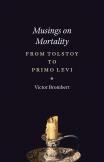Where is Thy Sting?
Almost invariably, most of us go through life as if death is something that happens to other people. Yet every day that passes means we have one less day to live. Death is Time’s shadow. Gnosticism and acedia assure death’s prominence in Modernism.
Victor Brombert, now late in life, examines the place of death in the work of eight modern authors, nearly everywhere displaying a mature critical acumen and moving effortlessly among authors whose works he reads in the original languages. All eight, except for Tolstoy, were born in the 20th century; and except for J. M. Coetzee, all of them are now dead.
No novelist has dealt any more directly with the fact of death than Tolstoy in his classic, The Death of Ivan Ilych, where “Tolstoy’s unstated cultural references invite us to consider The Death of Ivan Ilych as a meditation on mortality.” Brombert finds only “ambivalence” in the meaning of Ivan’s last moments and concludes that Ivan’s “Epiphany” “can stand as an encounter with nothingness or as a metaphor of revelation.” He wonders if Ivan’s last thought (“Death is finished…it is no more”) alludes to John Donne but is unaware that both Donne and Tolstoy are recalling Paul’s words, “Death shall be no more: Death shall die.” Here and elsewhere, Tolstoy’s “cultural references’’ include the New Testament; Ivan’s dying is filled with them.
In Thomas Mann’s Death in Venice, death is the victor. Aschenbach, a writer hoping for a rejuvenating rest in Venice, allows his obsessive stalking of a young Polish boy vacationing there with his family to destroy him, as he refuses to leave during a cholera epidemic. Mann’s story, as Brombert shows, also portends Europe’s heading into an abyss. Aschenbach’s erotic fascination has something demonic about it, as Brombert observes, and is part of “the death wish [that] is a recurrent motif in Mann’s work.” The “self-destructive course of the artist…and that of a diseased society” in the Venetian novella “prefigure themes” developed in other of Mann’s major works.
Franz Kafka’s work is also suffused with death. His incessant ruminations on “the miseries of the human body” began well before he contracted tuberculosis. In “The Metamorphosis,” Gregor Samsa, having become a disgusting bug, refuses food his sister offers him. The “rejection of food” is a “recurrent Kafka motif,” Brombert observes. Gregor muses, “I am hungry enough, but not for that kind of food.” Perhaps a dim longing for some other kind of food stirred Kafka’s taste for Kierkegaard years later. Brombert recalls in that connection Thomas Mann’s characterization of Kafka as a “religious humorist.” But Kafka could not shake a preoccupation with death and suicide, which he comes to see as liberation.
Gnosticism can be recognized in much of this pessimism, not only in Kafka. Virginia Woolf shares with him a sense of imminent catastrophe in a meaningless world. J. M. Coetzee’s “gloomy view of history” recalls Mann’s despair over Europe. As a young man, Albert Camus had written, “There is no love of living without the despair of living.” For Woolf, the temporary solace found in literature and writing can only temporarily stave off the haunting presence of death (“It will end, it will end”).
If Coetzee is resigned to the bleak prospects of empires, wars and human cruelty, Camus eventually sees beyond them. His famous use of Sisyphus, as Brombert says, was only “a starting point.” Camus escaped from the spiritual wasteland of his Existentialist confederates. In his Nobel speech, he referred to the “intellectual grand inquisitors who threaten to establish kingdoms of death (‘les royaumes de la mort’).” Brombert concludes that “ultimately his musings on mortality lead him to a notion of transcendence.” (Brombert seems unaware that in the year before he died, Camus requested baptism.)
Essays on George Bassani (The Garden of the Finzi-Continis) and Primo Levi foreground the great outpouring of death in the Shoah. Levi had seen much of death in Auschwitz. Yet, like Woolf, Levi had flirted with suicide even as a child. Paradoxically, Auschwitz did not lead to his eventual suicide; Auschwitz postponed it. There, “survival remained the supreme value.” Brombert attributes Levi’s later self-destructive bent to his conviction that “Death is at the center of nature,” adding that “a sense of the sin of existing seems to underlie his recurrent sensation of an immense void.” Levi felt “political and cultural despair.” Brombert sees him as “a suicidal Job.”
This article also appeared in print, under the headline “Where is Thy Sting?,” in the December 22-29, 2014, issue.








